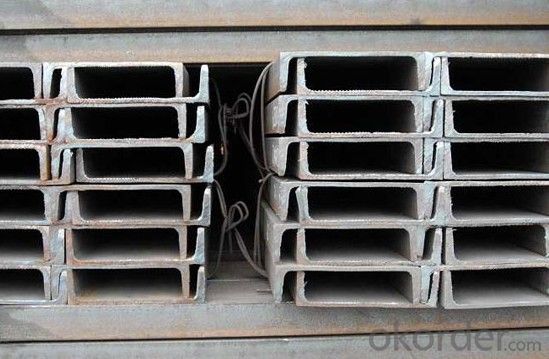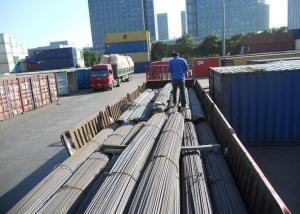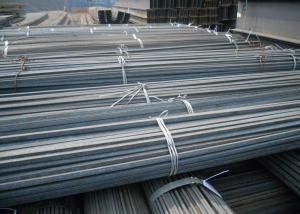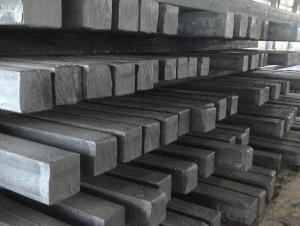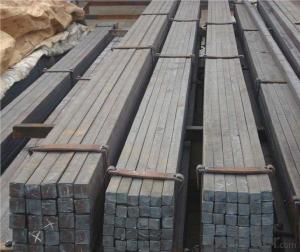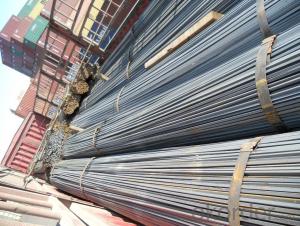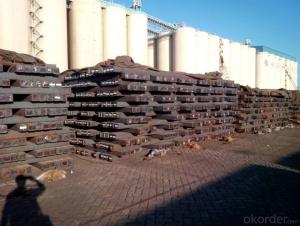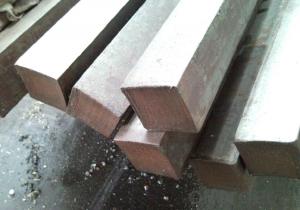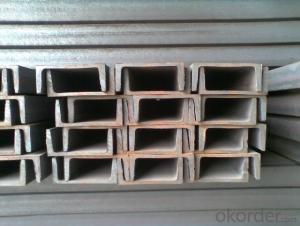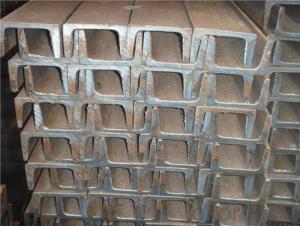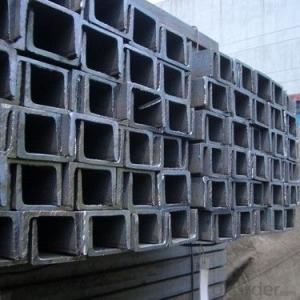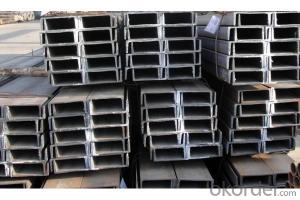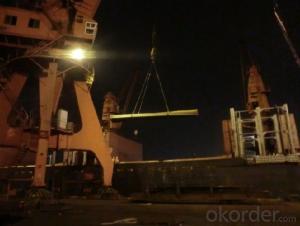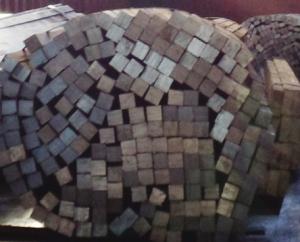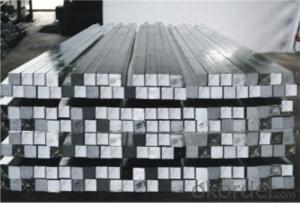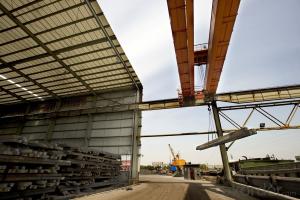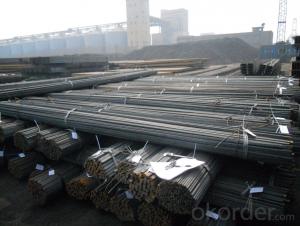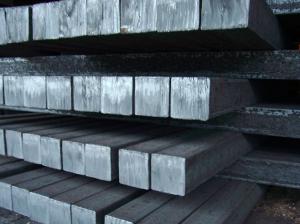140mm*60mm u channel steel for construction
- Loading Port:
- Tianjin
- Payment Terms:
- TT or LC
- Min Order Qty:
- 25 m.t.
- Supply Capability:
- 100000 m.t./month
OKorder Service Pledge
OKorder Financial Service
You Might Also Like
Product Description:
OKorder is offering 140mm*60mm u channel steel for construction at great prices with worldwide shipping. Our supplier is a world-class manufacturer of steel, with our products utilized the world over. OKorder annually supplies products to European, North American and Asian markets. We provide quotations within 24 hours of receiving an inquiry and guarantee competitive prices.
Product Applications:
140mm*60mm u channel steel are ideal for structural applications and are widely used in the construction of buildings and bridges, and the manufacturing, petrochemical, and transportation industries.
Product Advantages:
OKorder's u channel steel are durable, strong, and resist corrosion.
Main Product Features:
· Premium quality
· Prompt delivery & seaworthy packing (30 days after receiving deposit)
· Corrosion resistance
· Can be recycled and reused
· Mill test certification
· Professional Service
· Competitive pricing
Product Specifications:
Prime Hot Rolled Channel Steel from China GI Channel Steel Channel Details
Standard: | AISI,ASTM,BS, DIN,GB,JIS | Dimensions: | 50*37*4.5mm-400*104*14.5mm | Grade: | Carbon steel |
Place of Origin: | Shanghai China (Mainland) | Brand Name: | Baosteel Masteel Ansteel Shousteel Shasteel | Model Number: | Q195,Q215,Q235, A36,SS400,SS540 |
Shape: | GI Channel | Application: | Construction;Vehicle manufacturing; Industrial structure etc. | Perforated Or Not: | Not Perforated |
manufacturing technique: | Hotrolled Can be processed again repeatedly | sulphur content: | Q235B/S(0.02)% S355JR/S(0.013)% | Phosphorus Content: | Q235B/P(0.03)% S355JR/P(0.012)% |
silicon content: | Q235B/Si(≥0.19)% S355JR/Si(≥0.002)% | manganese content: | Q235B/Mn(0.45)% S355JR/Mn(1.35)% | Carbon Content: | Q235B/C(0.12-0.20)% Q3S355JR/C(0.12-0.20)% |
elongation: | Q235B/26min S355JR/26min | strength of extension: | Q235B/420MPa S355JR/485MPa | Yield Strength: | Q235B/235-280MPa S355JR/335-360MPa |
breed classify: | semi-killed steel or killed steel |
Packaging & Delivery
| Packaging Detail: | Prime hot rolled gi channel from china 1. It can be packed by container or bulk vessel. 2. 20ft container can load 25 tons, 40ft container can load 26 tons. 3.Standard export seaworthy package, it use wire rod with bundle according product's size. 4.Or we can make it as your requirement. |
| Delivery Detail: | 15 working days after received the deposit or L/C. |
Prime Hot Rolled Channel Steel from China GI Channel Steel Channel Specifications
Prime hot rolled gi channel
Competitive price
Fast delivery time
Customized length
FAQ
Q1: How soon can we receive the product after purchase?
A1: Within three days of placing an order, we will begin production. The specific shipping date is dependent upon international and government factors, but is typically 7 to 10 workdays.
Q2: What makes stainless steel stainless?
A2: Stainless steel must contain at least 10.5 % chromium. It is this element that reacts with the oxygen in the air to form a complex chrome-oxide surface layer that is invisible but strong enough to prevent further oxygen from "staining" (rusting) the surface. Higher levels of chromium and the addition of other alloying elements such as nickel and molybdenum enhance this surface layer and improve the corrosion resistance of the stainless material.
Prime Hot Rolled Channel Steel from China GI Channel Steel Channel Pictures
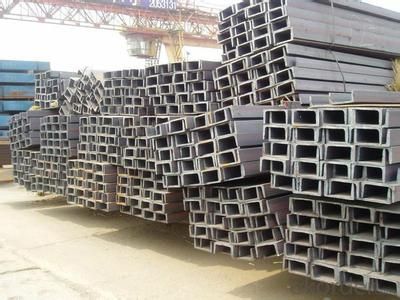
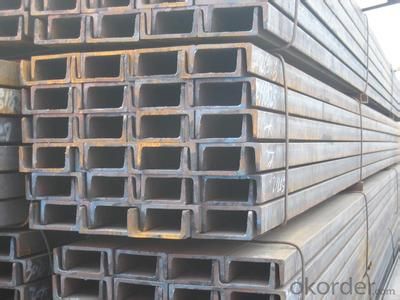
- Q: Are steel squares resistant to rust and corrosion?
- Yes, steel squares are generally resistant to rust and corrosion. Steel squares are commonly made from stainless steel, which contains a high percentage of chromium. Chromium is a key element that provides stainless steel with its corrosion-resistant properties. It forms a protective layer on the surface of the steel, known as a passive film, which prevents oxygen from reaching the underlying metal and thus inhibits the formation of rust. However, it is important to note that the level of resistance to rust and corrosion may vary depending on the quality of the steel used. Higher-quality stainless steel squares will have a higher resistance to rust and corrosion compared to lower-quality steel squares. Additionally, the maintenance and care given to the steel squares can also affect their resistance. Regular cleaning and proper storage can help prolong their lifespan and maintain their resistance to rust and corrosion.
- Q: Can a steel square be used for marking out cuts on materials?
- Marking out cuts on materials can be done using a steel square. A steel square, also referred to as a framing square or carpenter's square, is a versatile tool widely utilized in carpentry and woodworking. It comprises a long arm and a shorter arm positioned at a right angle, creating an L shape. The long arm is typically employed for marking straight lines, while the shorter arm is used to create 90-degree angles. When marking cuts on materials like wood, metal, or plastic, a steel square ensures accuracy and precision. By aligning the long arm with the material's edge, a straight line can be formed, and the shorter arm guarantees a perfect 90-degree angle. By firmly holding the steel square against the material and using a pencil or scribe, desired cuts can be easily marked. Using a steel square for marking cuts not only ensures precise measurements and angles but also guarantees consistent and uniform results. Carpenters, woodworkers, metalworkers, and other craftsmen who require accurate and clean cuts frequently employ this tool. To summarize, a steel square is an excellent tool for marking cuts on materials, providing accuracy, precision, and consistency throughout the cutting process.
- Q: Can a steel square be used for checking the alignment of tiles?
- Yes, a steel square can be used for checking the alignment of tiles. A steel square is a versatile tool that is commonly used in carpentry and tile work. Its straight edges and right angles make it ideal for ensuring that tiles are properly aligned and level. By placing the steel square against the edges of the tiles, one can easily determine if they are aligned correctly and make adjustments if needed. Additionally, the steel square can also be used to check the corners of the tiles, ensuring that they form perfect right angles. Overall, a steel square is a reliable tool for checking tile alignment and can help achieve a professional and aesthetically pleasing result.
- Q: Can a steel square be used for checking the alignment of a scroll saw table?
- Checking the alignment of a scroll saw table can be done with a steel square. A steel square is a versatile tool commonly used in woodworking and metalworking to check the accuracy and alignment of different components. To ensure the table is perfectly perpendicular to the blade, which is vital for precise cuts, a steel square can be used. By placing the steel square against both the table and the blade, it is easy to determine if the alignment is correct. Any deviations can be adjusted to ensure proper alignment, leading to better cutting accuracy and quality.
- Q: Can a steel square be used for checking the squareness of a picture frame corner?
- Checking the squareness of a picture frame corner with a steel square is not ideal. Although a steel square is commonly used in carpentry and construction, it may not be practical or accurate for this purpose. Picture frames are typically smaller and a steel square may be too large and cumbersome. Moreover, picture frames often have decorative elements or beveled edges that may not align perfectly with a steel square. It is advisable to use a specialized tool like a framing square or a precision square specifically designed for checking picture frame corners. These tools are smaller, more precise, and better suited for this task.
- Q: What are some common applications for a steel square in tile installation?
- A steel square, also known as a framing square or carpenter's square, is a versatile tool that can be useful in tile installation. Some common applications of a steel square in tile installation include: 1. Checking squareness: A steel square is ideal for checking if the walls and corners are perfectly square. This is crucial in ensuring that the tiles are laid straight and in alignment. 2. Marking straight lines: A steel square can be used to mark straight lines on the floor or walls, which helps in guiding the installation process. It ensures that the tiles are placed evenly and in a neat pattern. 3. Determining tile layout: By using a steel square, you can easily lay out a grid pattern for the tiles. This allows you to determine the size and placement of each tile accurately, creating a balanced and symmetrical design. 4. Cutting tiles: When cutting tiles, a steel square can act as a guide to ensure precise and straight cuts. By aligning the square with the marked line on the tile, you can score and cut along the edge, resulting in clean and accurate cuts. 5. Creating a slope: In some cases, a steel square can be used to create a slope for drainage purposes. By tilting the square at a specific angle, you can determine the slope needed and mark the appropriate lines for the tile installation. Overall, a steel square is a valuable tool in tile installation as it helps ensure accuracy, straight lines, and proper alignment. It can save time and effort by providing a reliable guide for various tasks involved in tiling projects.
- Q: How do you use a steel square to lay out a right angle?
- To use a steel square to lay out a right angle, you would place the long side (blade) of the square against one side of the object or surface where you want the right angle. Then, you would align the short side (tongue) of the square with the other side, making sure it is perpendicular to the blade. Once aligned, you can mark along the edges of the square to create a right angle.
- Q: Can a steel square be used for drywall taping?
- Yes, a steel square can be used for drywall taping. While there are specific tools designed specifically for drywall taping, such as a drywall taping knife or a trowel, a steel square can still be effective in certain situations. A steel square can be used to measure and mark straight lines, which is important when cutting drywall sheets or marking the placement of joint tape. It can also be used as a straight edge to ensure clean, straight lines when applying joint compound or smoothing out the tape. However, it is important to note that a steel square may not be as versatile or efficient as tools specifically designed for drywall taping, so it may not be the best option for professional drywallers or large-scale projects.
- Q: How do you use a steel square to determine the angle of a compound cove cut?
- To determine the angle of a compound cove cut using a steel square, adhere to the following instructions: 1. Prioritize the cleanliness and good condition of your steel square, ensuring that all necessary markings and measurements are easily visible. 2. Firmly position the steel square against the desired piece of wood or material for the compound cove cut. Align the longer side of the square with the bottom edge of the material. 3. Adjust the square's placement so that the shorter side stands perpendicular to the longer side and aligns with the material's side edge. 4. Once the square is appropriately positioned, utilize a pencil or marking tool to trace along the inside edge of the longer side, creating a straight line on the material. 5. Proceed to rotate the square along the material's bottom edge, maintaining alignment with the side edge. This rotation will form a second straight line on the material, intersecting the initial line you drew. 6. The point where these two lines intersect denotes the compound cove cut angle. To measure this angle accurately, employ a protractor or the angle measuring function of your steel square. 7. Align the protractor or angle measuring feature with the two lines, ensuring it rests precisely on the intersection point. Consult the protractor or steel square for the angle measurement, which will provide the precise angle of the compound cove cut. By adhering to these steps and utilizing a steel square correctly, you can accurately determine the angle for a compound cove cut on your material. Remember to double-check your measurements and ensure proper alignment of the square to achieve precise results.
- Q: Can a steel square be used for checking the squareness of a window opening?
- No, a steel square cannot be used for checking the squareness of a window opening. A steel square is a measuring tool used in carpentry and masonry to determine right angles and measure angles and distances. While it can be useful for many applications, it is not designed specifically for checking the squareness of a window opening. To ensure the window opening is square, specialized tools such as a carpenter's square or a laser level should be used. These tools are specifically designed to accurately determine squareness and ensure proper installation of windows.
Send your message to us
140mm*60mm u channel steel for construction
- Loading Port:
- Tianjin
- Payment Terms:
- TT or LC
- Min Order Qty:
- 25 m.t.
- Supply Capability:
- 100000 m.t./month
OKorder Service Pledge
OKorder Financial Service
Similar products
Hot products
Hot Searches
Related keywords





